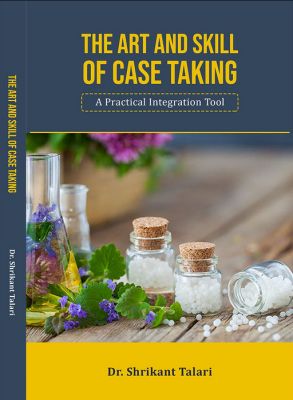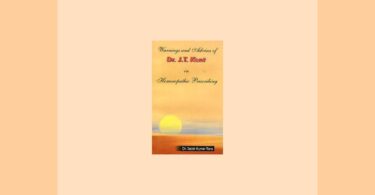317 pages
Hardcover – £48.01
Paperback – £32.01
APK Publishers, 2023 – Website: www.apkpublishers.com
ISBN: 9798393299613
The books on my shelves fall into two categories – the ones I read and refer to on a regular basis and those gathering dust. The ones which are helpful, invaluable in practice, I use to help become a better practitioner and achieve that “rapid, gentle and permanent restoration of health”.
I believe I’m holding one such book in my hands. This is the author’s first book. And it’s impressive. Dr Talari found his love for homeopathy during his studies. It was through the writings of Swami Vivekananda and the realisation that homeopathy is his dharma, his life’s work and purpose, and that to which he has utterly dedicated himself in this incarnation.
His love for challenging cases led him to specialise in the treatment of cancer and he is now responsible for the Cancer Care Clinic at Prana Homeopathy Yoga Centre, Pune, India. He is an established and respected facilitator and lecturer with The Other Song and regularly offers webinars about the role of homeopathy in cancer treatment. His main focus is to be a better homeopathic prescriber. His book guides us to achieve the same.
I’ve read “The Art and Skill of Case Taking” at least twice now and this brings the certainty that it will be referred to again and again. The book offers a practical approach to refining the art of being a better classical homeopath. It is a tool to be used and referred to. I have already written in the margins and highlighted numerous portions of the text to refer to later.
Dr Sankaran endorses the book in the forward where he points out that there are very few books on the subject of case taking, and that this book “emphasises the importance of taking a good case with reference to the pathological, physical, mental, delusion, sensation, energy pattern and also observation of the patient”.
He says we get a wonderful insight into Dr Talari’s practice and his endeavours to become a better prescriber. “The case taking can be considered successful when all the information from all aspects converge on the same remedy – R. Sankaran.
Dr Talari takes us through the process of how to achieve this in practice.
The contents pages make it easy to navigate our way through the book and makes finding particular aspects of case taking simple and straightforward so we can find exactly what we are looking for. There are easy to follow chapter headings and well structured, well organised and consistent titles.
Overview
The book takes us on a step by step journey through the ways to collect those all important characteristic symptoms vital in a good case taking. It gives examples through clear cases to simplify the process of drawing out those symptoms from the client. This is achieved through a plethora of cases across the whole text which are used to illustrates the many points covered in the book.
The main body of the book is divided into sections covering Physical symptoms and Mind symptoms. Both of these sections are then divided to cover the topics: Structure, Areas and Skills, which are then further sub-divided to cover every aspect of expert case taking.
The opening chapter, The Aim of Case Taking, starts with a bullet pointed synopsis underlined with the corresponding aphorism from the Organon which Dr Talari consistently refers to throughout. Then a case to illustrate these points.
In the Physical section, Structure takes us through a step-by-step process to elicit a complete symptom from the client (Cause; Onset, Duration, Progress; Location; Sensations and complaints; Modalities; Concomitant; and then Mind in the Physical section and Physical in the Mind section). Thus, we find ourselves building a complete symptom with ease.
Areas, in the Physical section, starts off with looking at the Physical Constitution of the patient and the importance of observation, followed by Diagnosis; Investigation and Lifestyle; Family History and then the all important Physical Generals.
We then move on to the Skills section where we explore the qualities needed for good homeopathic case taking: detective-like skills, open ended questions, clinical/examination skills, acute senses and attentiveness and spirit/essence. The skills are, once again, illustrated beautifully with cases to really help us understand and appreciate the importance of these skills and, more importantly, how to attain them. This section is nicely finished off with a diagram showing us an overview of taking the case through Physical symptoms.
The Mind section of the book is once again divided into Structure, Areas and Skills. In the Structures chapter, Dr Talari again addresses how to build a complete symptom but this time using Mind symptoms.
The Areas chapter covers the different areas needed to be explored to find those all important mind symptoms: Observation; Chief complaint; Nature; and in the Uncompensated Areas section he takes us through hobbies and interests, childhood, dreams, stressful or intense situations and things that affect the patient or sensitivities. Once again, we learn these through case examples.
The Skills section for the Mind re-visits how to accomplish asking open ended questions, this time with a view to eliciting specifically Mind symptoms from the client. Stillness – which is something that we may not have considered important in case taking – helps us to really prepare for our clients.
The art of listening; looking for intensity; maintaining cause; confirmatory questions and how to identify common and characteristic symptoms, these are all covered with a focus on Mind symptoms.
Moving onto The Art of Eliciting Keynote, Dr Talari presents a synopsis of case taking and then moves into Special Areas.
This helpful chapter covers paediatric case taking; how to take pathological cases and difficult scenarios in daily practice: reserved patients; intellectual patients and talkative patients. These are often problematic areas to work in and elicit symptoms – especially for the student and novice homeopath.
At the back of the book, Dr Talari has included his Homeopathic Case Record Form. This is a thoroughly in depth questionnaire in 7 parts covering every aspect of the patient.
There is then an indexed and catalogued list of the cases presented in the book which are numbered throughout for ease of reference. The index shows the chapter the case appears in, the sub-heading in the chapter, age of the patient, gender, chief complaint/probable diagnosis, the remedy prescribed and the potency. This is a useful tool to re-locate the cases in the book – 53 in total.
This is a splendid book – not only because there are so few really useful books in this area of homeopathy, but also because it really is very good! I would be very interested in hearing Dr Talari’s approach to acute case taking – a topic for the next book maybe?
The Art and Skill of Case Taking is in depth, detailed and easy to follow and navigate. The text shows Dr Talari’s dedication and expertise in the field. The book is not only a useful tool for the student and the novice homeopath but also for the experienced homeopath to really fine tune and hone their case taking skills. I would like to see this book on the reading list in all of our homeopathic colleges. It is definitely going to be referred to regularly in my own practice.






